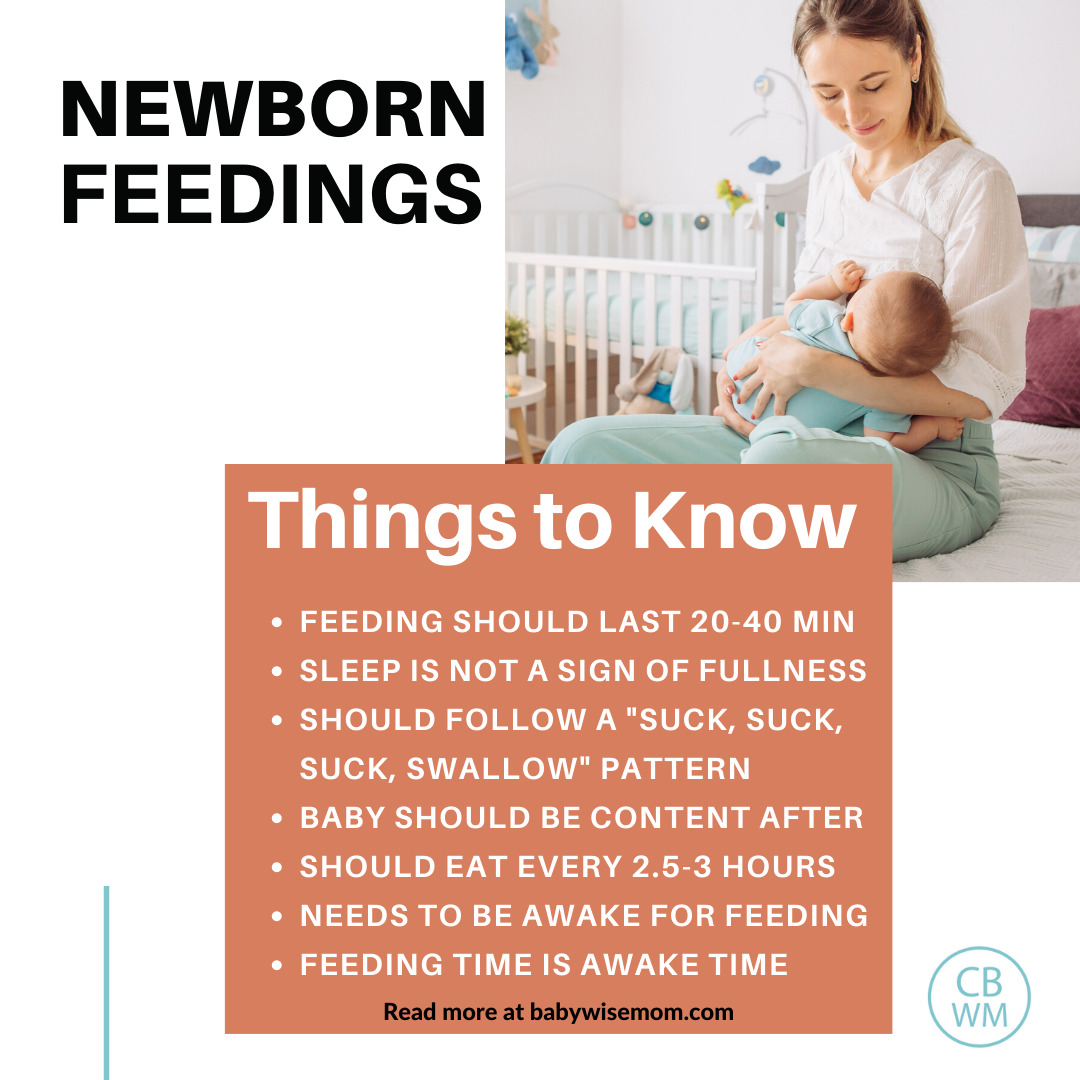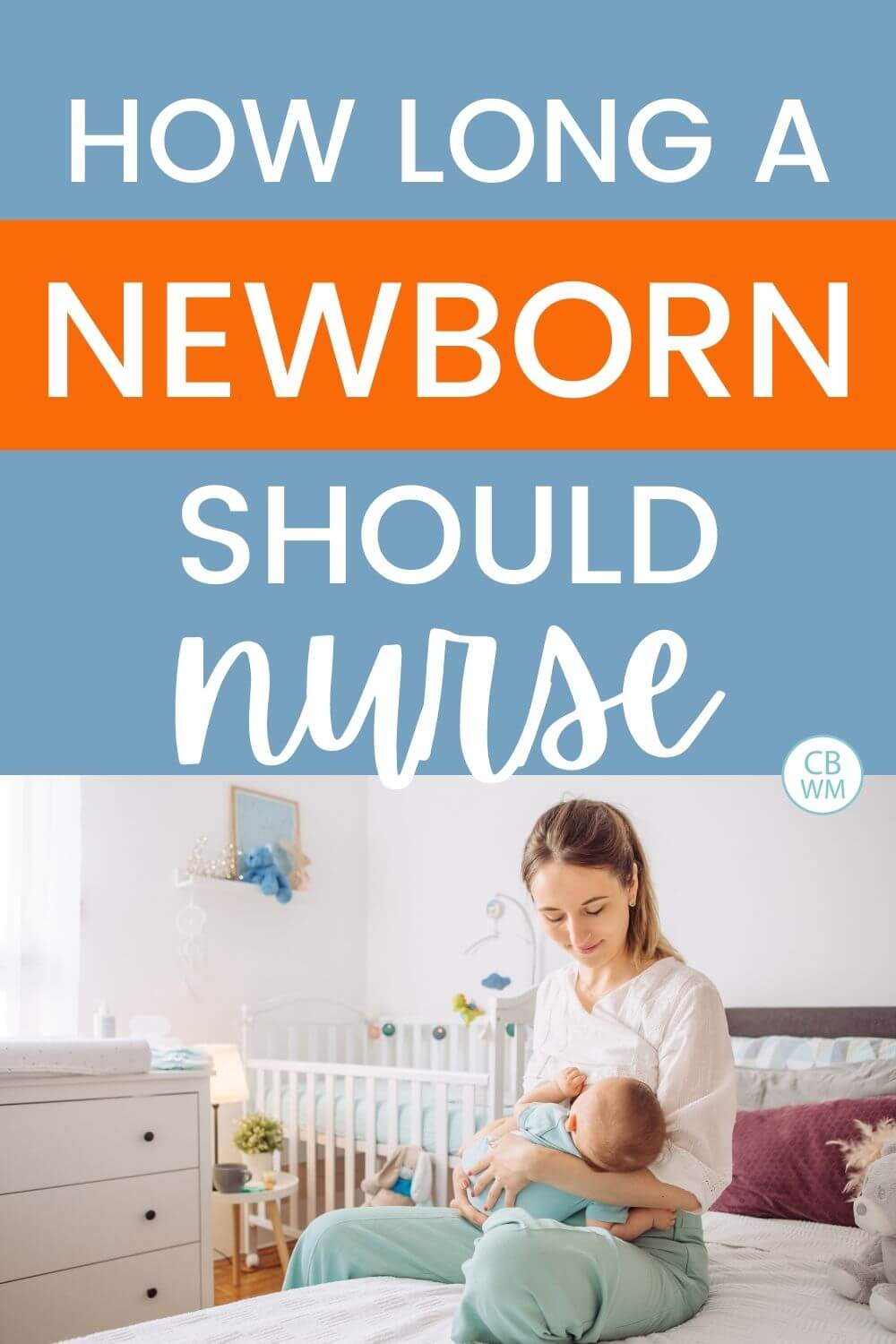How long should a newborn nurse? How do you know if a newborn baby is full or not? Get your answers here.

Are you wondering how long a breastfeeding session should last for a newborn?
The question of how long a baby should eat is at the forefront of every newborn mother’s mind.
Even experienced moms run through the question since every baby is different.
This is especially true for breastfeeding moms because they have no idea the number of ounces baby is eating.
There are variables that will change how long a baby will take to eat. Some of those include how much milk mom has, how fast the milk comes out, the letdown, how fast baby can drink, how strong of a sucker baby is, and how much food baby needs.
So how do you know what your individual newborn needs?
My friend who is a lactation consultant at our hospital says the only way to know for sure if baby is getting enough to eat is to get a scale–an accurate scale–and do weighing before and after feeds.
Of course, most of us can’t afford said scale, so we need other guidance.
Post Contents
Newborn Feedings Should Last 20-40 Minutes
People often wonder if a 10 minute feed is long enough for a newborn.
For most newborns, 10 minutes is not long enough to get a full feeding in.
Tracy Hogg says that for the first 6-8 weeks, an average-weight baby’s feeding will take 20-40 minutes (The Baby Whisperer Solves All Your Problems
Lactation consultants say to aim for at least 10, but preferably 15-20, minutes per side initially. When you double that (for two sides), you are looking at 20-40 minutes to feed a newborn.
Those numbers are in sync with what Hogg is saying for the amount of time spent eating.
If you breastfeed, take note that initially, your milk supply will not be up yet. This means your little one will have less breast milk to get since there will only be a small amount, so the time spent eating might be less in those first several days.
If your baby starts to just play with the nipple, she is done feeding.
Remember that with a newborn, you are working to build your milk supply so you have enough milk for the duration of breastfeeding.
Sleep Is Not A “Full” Sign
A baby falling asleep is not a sign that the baby is full–especially in a breastfed baby. This is also especially true with newborns, who are notoriously sleepy.
Most breastfed babies will fall asleep about 10 minutes into a feeding because of oxytocin in the milk (page 99). Oxytocin can make you and your baby sleepy.
So when your newborn falls asleep when eating, do not assume this means she is full.
>>>Read: Keeping a Newborn Awake During Feedings
Count Sucks
One sign that infants are done with one side is how many sucks she takes before swallowing.
I read somewhere, and I think it was in a Baby Whisperer book but I don’t see it so I am not sure, that if baby is sucking more than 4 or 5 times before swallowing, you can switch sides.
After the initial letdown, the baby will start to “suck, suck, suck, swallow.” If baby is just sucking with no swallowing, then she is asleep. If she is sucking a lot of times before swallowing, then it is time to switch sides.
Watch Growth and Disposition
One of the best ways to know if your baby is getting enough food is to watch growth patterns, diaper output, and also your baby’s disposition.
If she is content and sleeping well as well as growing, then she is eating long enough. If she is staying on her growth curve, she is getting enough food. If she is sleeping well for naps and night, then she is getting enough food.
If she has a normal amount of wet diapers for her age, she is getting enough food. You also want to watch dirty diaper output–pay attention to the stools.
If the above things are not true, then she is either having a growth spurt or she needs to spend more time eating.
Note that watching growth and disposition is important to monitor your milk supply. If your supply is down, your little one might not eat as long. So if your little one is frustrating and trying to eat, check your milk supply.
And always look into milk production if weight gain becomes a concern.
Lip Tie and Tongue Tie
Feeding problems are not always associated with breast milk supply issue. Sometimes there can be problems because of a lip tie or tongue tie.
A tie makes it harder for your little one to eat, which wears him out faster and makes him sleepier. It can also make him gassy. It also makes it so the latch is not correct, which can hurt supply.
If you are having troubles, check this post out and talk to your baby’s doctor.
Signs of Hunger
If your little one is fussy, you might be wondering why and worry that it is tied to something with breast feeding. You might also wonder how to tell if your baby is hungry. See this post for help: Hunger Cues: How To Know if Baby Is Hungry
Always follow feeding cues. If your baby is hungry, feed her.
Real Life Examples
Several of my babies were very different eaters as newborns.
Brayden, my oldest, was a very slow nurser. I realized later that he often was falling asleep while nursing. I thought he was taking forever, but he was really catnapping.
Even once I got him to stay awake and eat, he took around 40 minutes to eat, putting him on the long end of the range discussed above.
Then Kaitlyn came along. She was a super fast breastfeeder. She was at or below the fastest recommendations for time listed above basically from birth. However, she was growing well, sleeping well, and her diaper output was on track. She had lots of baby rolls, even though she had reflux, so I knew she was getting the food she needed.
McKenna, my third, was in between the two. She was right at average. Brinley was the same.
Each baby is different and it will take you some time to learn what each baby needs after she is born.
Key Newborn Feeding Points
There are some important things to remember as you feed your baby.
One is to wake your newborn to feed. When it is time to eat, wake up your baby to eat.
Time between feeding should be 2.5-3 hours for most newborns.
Another is to keep your baby awake for the feeding. Do your best to keep baby awake and have some playtime afterward. For young newborns, “playtime” might be as short as a diaper change before it is nap time again.
Remember that feeding time is part of your newborn’s wake time, so that is one reason you want to keep baby awake for feedings. Another is that it enables you to make sure baby gets a full feeding.
Setting up a newborn feeding schedule is so helpful for you to have a general idea of what your baby should be doing when. To see sample schedules used by real babies, start with my first month newborn schedule post here. From there, you can get to every month of baby’s first year.
Finally, feeding a newborn is a lot of work! It takes all of your focus and energy to keep your newborn awake.
There will be feedings this proves to be impossible. The ideal is that baby is awake for the feeding, but when (yes, WHEN) that doesn’t happen and baby dozes instead, do not freak out! It will be fine. This is normal. Just try again the next feeding.
This hard work doesn’t last forever. The day does come that you can relax and even read while you feed your baby.
Conclusion
The good news is that while it takes some time to figure each individual baby out, you will get there and will be able to feed your baby with confidence. You don’t need to be an expert immediately. Have some patience with yourself. Pay attention to your baby and you will be able to figure things out.
Related Posts
- How I Breastfed for 12 Months Even When Everything Went Wrong
- Sleepy Newborns: Work to Feed for 10 Minutes
- Keeping a Newborn Awake During Feedings
- How To Tell if Baby is Getting a Full Feeding
- Optimal Waketime Lengths


This post originally appeared on this blog January 2011

